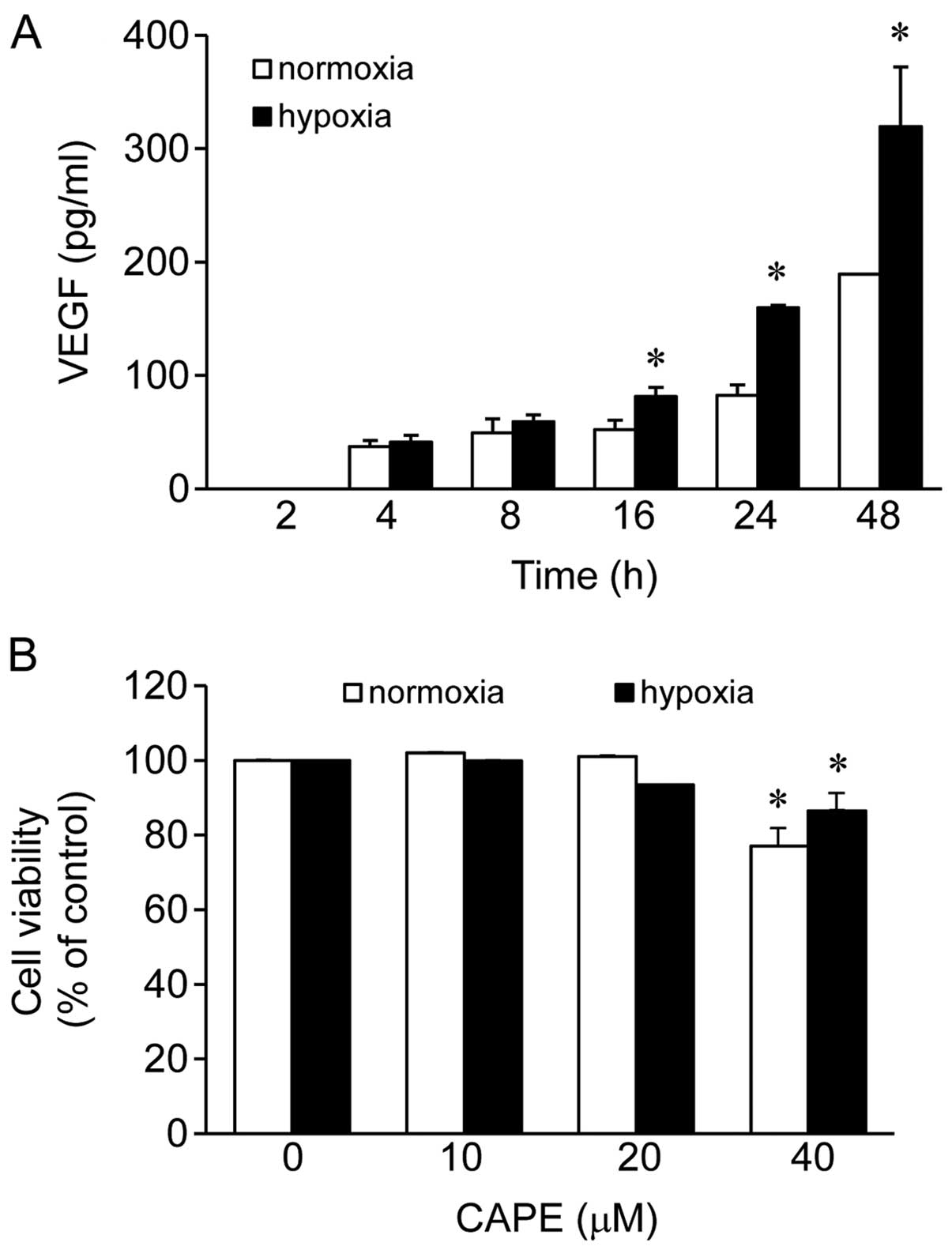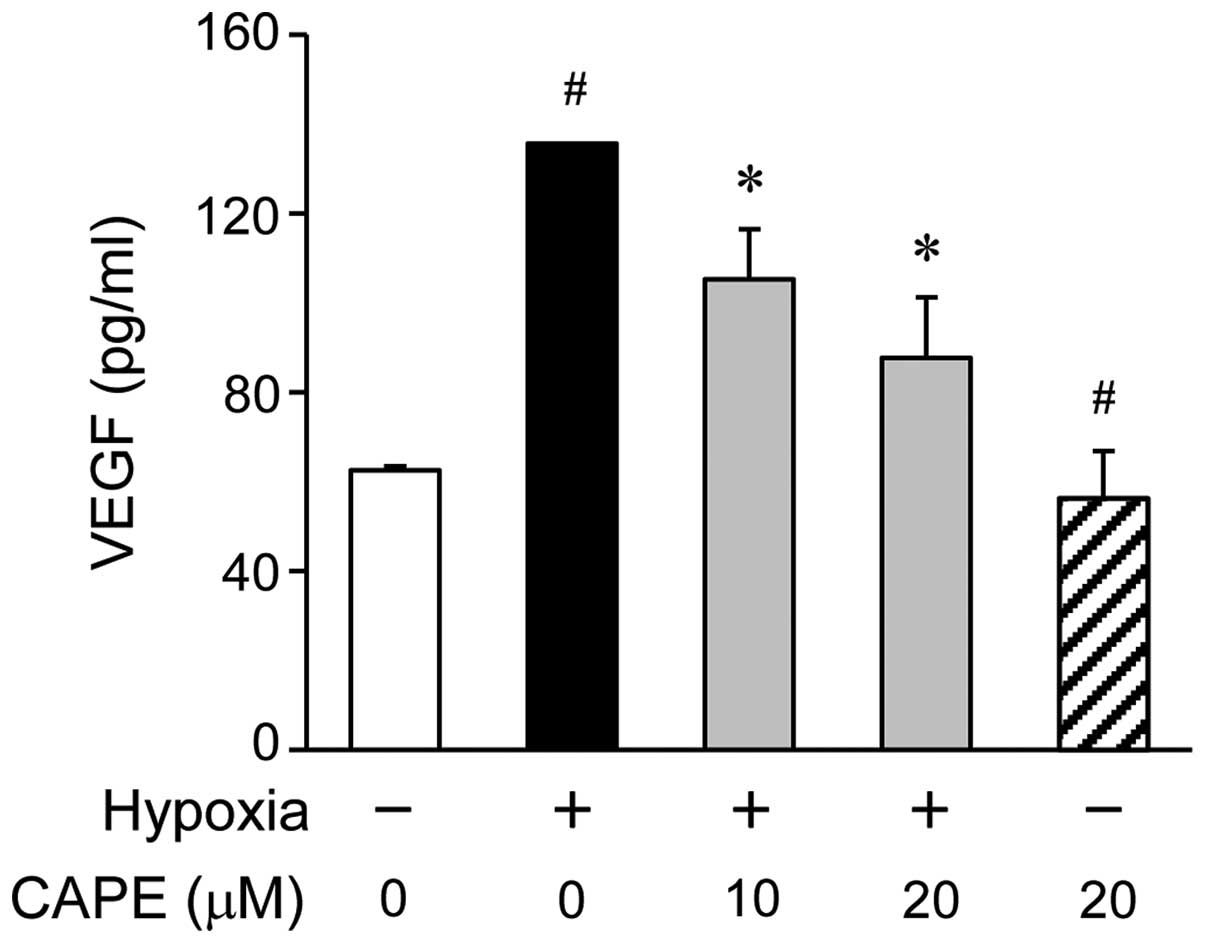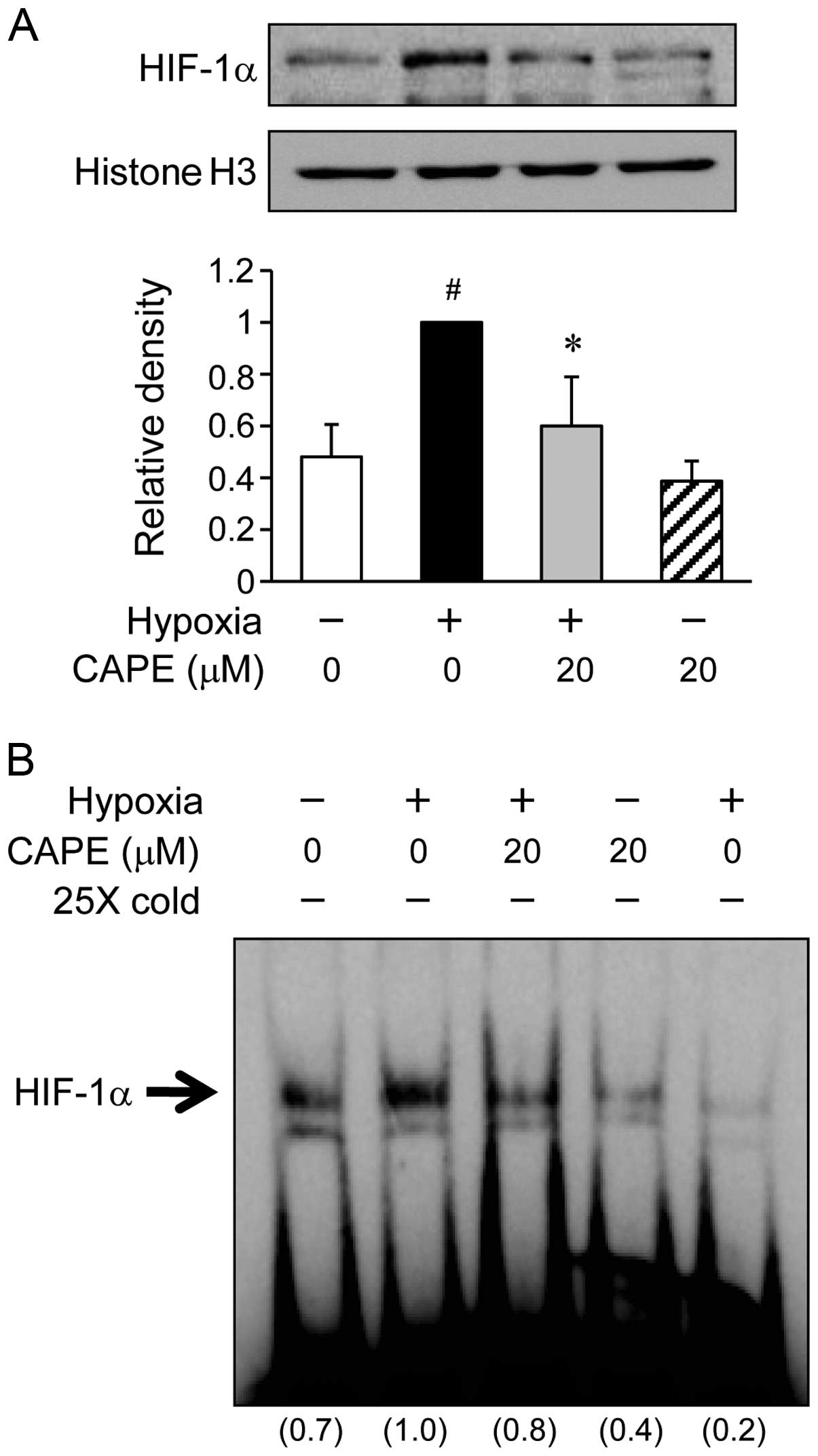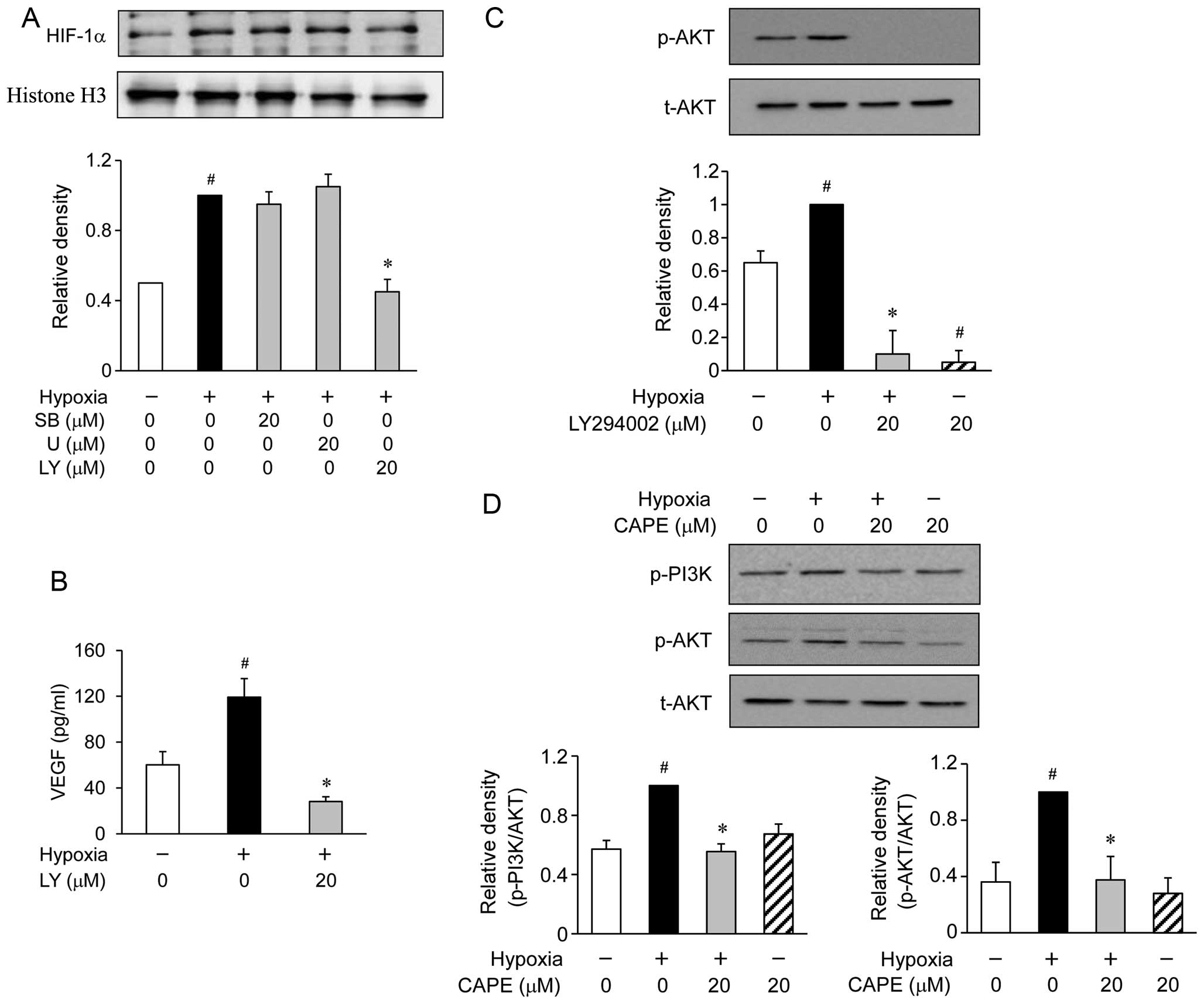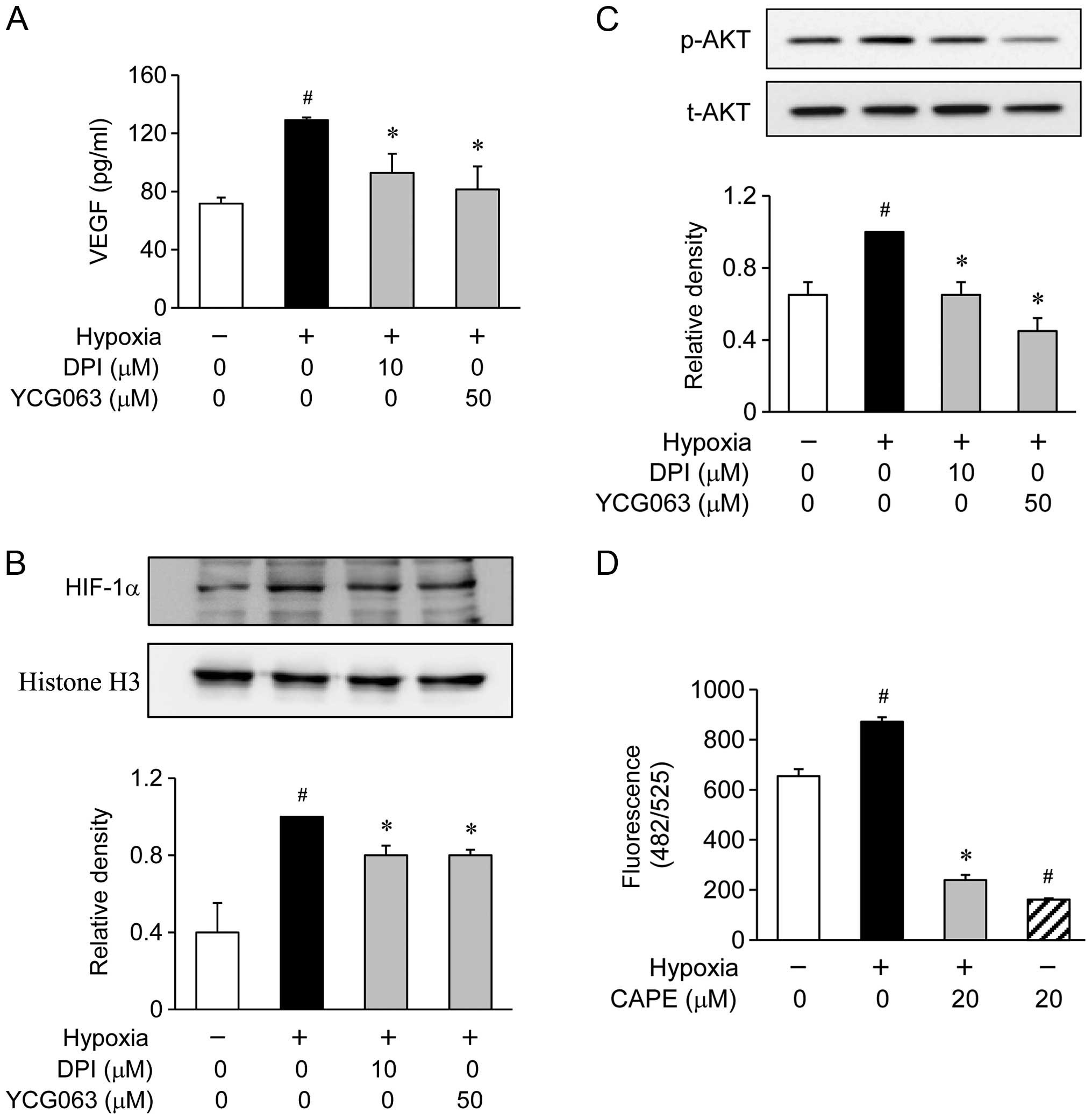|
1
|
Oh JH, Oh J, Togloom A, Kim SW and Huh K:
Effects of Ginkgo biloba extract on cultured human retinal pigment
epithelial cells under chemical hypoxia. Curr Eye Res.
38:1072–1082. 2013. View Article : Google Scholar : PubMed/NCBI
|
|
2
|
Cao J, Zhao L, Li Y, et al: A subretinal
matrigel rat choroidal neovascularization (CNV) model and
inhibition of CNV and associated inflammation and fibrosis by VEGF
trap. Invest Ophthalmol Vis Sci. 51:6009–6017. 2010. View Article : Google Scholar : PubMed/NCBI
|
|
3
|
Campochiaro PA: Ocular neovascularization.
J Mol Med Berl. 91:311–321. 2013. View Article : Google Scholar : PubMed/NCBI
|
|
4
|
da Cruz L, Chen FK, Ahmado A, Greenwood J
and Coffey P: RPE transplantation and its role in retinal disease.
Prog Retin Eye Res. 26:598–635. 2007. View Article : Google Scholar : PubMed/NCBI
|
|
5
|
Jin J, Zhou KK, Park K, Hu Y, Xu X, Zheng
Z, Tyagi P, Kompella UB and Ma JX: Anti-inflammatory and
antiangiogenic effects of nanoparticle-mediated delivery of a
natural angiogenic inhibitor. Invest Ophthalmol Vis Sci.
52:6230–6237. 2011. View Article : Google Scholar : PubMed/NCBI
|
|
6
|
Vadlapatla RK, Vadlapudi AD and Mitra AK:
Hypoxia-inducible factor-1 (HIF-1): A potential target for
intervention in ocular neovascular diseases. Curr Drug Targets.
14:919–935. 2013. View Article : Google Scholar : PubMed/NCBI
|
|
7
|
Caprara C and Grimm C: From oxygen to
erythropoietin: Relevance of hypoxia for retinal development,
health and disease. Prog Retin Eye Res. 31:89–119. 2012. View Article : Google Scholar
|
|
8
|
Lutty G, Grunwald J, Majji AB, Uyama M and
Yoneya S: Changes in choriocapillaris and retinal pigment
epithelium in age-related macular degeneration. Mol Vis. 5:35–38.
1999.PubMed/NCBI
|
|
9
|
Pouysségur J, Dayan F and Mazure NM:
Hypoxia signalling in cancer and approaches to enforce tumour
regression. Nature. 441:437–443. 2006. View Article : Google Scholar : PubMed/NCBI
|
|
10
|
Vadlapatla RK, Vadlapudi AD, Pal D,
Mukherji M and Mitra AK: Ritonavir inhibits HIF-1α-mediated VEGF
expression in retinal pigment epithelial cells in vitro. Eye
(Lond). 28:93–101. 2014. View Article : Google Scholar
|
|
11
|
Moreira EF, Larrayoz IM, Lee JW and
Rodríguez IR: 7-Ketocholesterol is present in lipid deposits in the
primate retina: potential implication in the induction of VEGF and
CNV formation. Invest Ophthalmol Vis Sci. 50:523–532. 2009.
View Article : Google Scholar
|
|
12
|
Spilsbury K, Garrett KL, Shen WY,
Constable IJ and Rakoczy PE: Overexpression of vascular endothelial
growth factor (VEGF) in the retinal pigment epithelium leads to the
development of choroidal neovascularization. Am J Pathol.
157:135–144. 2000. View Article : Google Scholar : PubMed/NCBI
|
|
13
|
Kwak N, Okamoto N, Wood JM and Campochiaro
PA: VEGF is major stimulator in model of choroidal
neovascularization. Invest Ophthalmol Vis Sci. 41:3158–3164.
2000.PubMed/NCBI
|
|
14
|
Krzystolik MG, Afshari MA, Adamis AP,
Gaudreault J, Gragoudas ES, Michaud NA, Li W, Connolly E, O’Neill
CA and Miller JW: Prevention of experimental choroidal
neovascularization with intravitreal anti-vascular endothelial
growth factor antibody fragment. Arch Ophthalmol. 120:338–346.
2002. View Article : Google Scholar : PubMed/NCBI
|
|
15
|
Park SG, Lee DY, Seo SK, et al: Evaluation
of anti-allergic properties of caffeic acid phenethyl ester in a
murine model of systemic anaphylaxis. Toxicol Appl Pharmacol.
226:22–29. 2008. View Article : Google Scholar
|
|
16
|
El-Refaei MF and El-Naa MM: Inhibitory
effect of caffeic acid phenethyl ester on mice bearing tumor
involving angiostatic and apoptotic activities. Chem Biol Interact.
186:152–156. 2010. View Article : Google Scholar : PubMed/NCBI
|
|
17
|
Jin UH, Song KH, Motomura M, Suzuki I, Gu
YH, Kang YJ, Moon TC and Kim CH: Caffeic acid phenethyl ester
induces mitochondria-mediated apoptosis in human myeloid leukemia
U937 cells. Mol Cell Biochem. 310:43–48. 2008. View Article : Google Scholar
|
|
18
|
Beatty S, Koh H, Phil M, Henson D and
Boulton M: The role of oxidative stress in the pathogenesis of
age-related macular degeneration. Surv Ophthalmol. 45:115–134.
2000. View Article : Google Scholar : PubMed/NCBI
|
|
19
|
Izumi-Nagai K, Nagai N, Ohgami K, Satofuka
S, Ozawa Y, Tsubota K, Ohno S, Oike Y and Ishida S: Inhibition of
choroidal neovascularization with an anti-inflammatory carotenoid
astaxanthin. Invest Ophthalmol Vis Sci. 49:1679–1685. 2008.
View Article : Google Scholar : PubMed/NCBI
|
|
20
|
Apte RS, Richter J, Herndon J and Ferguson
TA: Macrophages inhibit neovascularization in a murine model of
age-related macular degeneration. PLoS Med. 3:e3102006. View Article : Google Scholar : PubMed/NCBI
|
|
21
|
Yu BC, Lee DS, Bae SM, et al: The effect
of cilostazol on the expression of matrix metalloproteinase-1 and
type I procollagen in ultraviolet-irradiated human dermal
fibroblasts. Life Sci. 92:282–288. 2013. View Article : Google Scholar : PubMed/NCBI
|
|
22
|
Wang H and Joseph JA: Quantifying cellular
oxidative stress by dichlorofluorescein assay using microplate
reader. Free Radic Biol Med. 27:612–616. 1999. View Article : Google Scholar : PubMed/NCBI
|
|
23
|
Uehara H, Luo L, Simonis J, Singh N,
Taylor EW and Ambati BK: Anti-SPARC oligopeptide inhibits
laser-induced CNV in mice. Vision Res. 50:674–679. 2010. View Article : Google Scholar :
|
|
24
|
Semenza G: Signal transduction to
hypoxia-inducible factor 1. Biochem Pharmacol. 64:993–998. 2002.
View Article : Google Scholar : PubMed/NCBI
|
|
25
|
Minet E, Michel G, Mottet D, Raes M and
Michiels C: Transduction pathways involved in hypoxia-inducible
factor-1 phosphorylation and activation. Free Radic Biol Med.
31:847–855. 2001. View Article : Google Scholar : PubMed/NCBI
|
|
26
|
Lee HS, Jun JH, Jung EH, Koo BA and Kim
YS: Epigalloccatechin-3-gallate inhibits ocular neovascularization
and vascular permeability in human retinal pigment epithelial and
human retinal microvascular endothelial cells via suppression of
MMP-9 and VEGF activation. Molecules. 19:12150–12172. 2014.
View Article : Google Scholar : PubMed/NCBI
|
|
27
|
Adamis AP and Shima DT: The role of
vascular endothelial growth factor in ocular health and disease.
Retina. 25:111–118. 2005. View Article : Google Scholar : PubMed/NCBI
|
|
28
|
Forooghian F, Razavi R and Timms L:
Hypoxia-inducible factor expression in human RPE cells. Br J
Ophthalmol. 91:1406–1410. 2007. View Article : Google Scholar : PubMed/NCBI
|
|
29
|
Ratcliffe PJ, O’Rourke JF, Maxwell PH and
Pugh CW: Oxygen sensing, hypoxia-inducible factor-1 and the
regulation of mammalian gene expression. J Exp Biol. 201:1153–1162.
1998.PubMed/NCBI
|
|
30
|
Ratcliffe PJ, Pugh CW and Maxwell PH:
Targeting tumors through the HIF system. Nat Med. 6:1315–1316.
2000. View Article : Google Scholar : PubMed/NCBI
|
|
31
|
Semenza GL: HIF-1: Mediator of
physiological and pathophysiological responses to hypoxia. J Appl
Physiol (1985). 88:1474–1480. 2000.
|
|
32
|
Sparkenbaugh EM, Ganey PE and Roth RA:
Hypoxia sensitization of hepatocytes to neutrophil
elastase-mediated cell death depends on MAPKs and HIF-1α. Am J
Physiol Gastrointest Liver Physiol. 302:G748–G757. 2012. View Article : Google Scholar : PubMed/NCBI
|
|
33
|
Liu Y, Zhang B, Zhang J, Wang S, Yao H, He
L, Chen L, Yue W, Li Y and Pei X: CAPE promotes the expansion of
human umbilical cord blood-derived hematopoietic stem and
progenitor cells in vitro. Sci China Life Sci. 57:188–194. 2014.
View Article : Google Scholar : PubMed/NCBI
|
|
34
|
Roos TU, Heiss EH, Schwaiberger AV,
Schachner D, Sroka IM, Oberan T, Vollmar AM and Dirsch VM: Caffeic
acid phenethyl ester inhibits PDGF-induced proliferation of
vascular smooth muscle cells via activation of p38 MAPK, HIF-1α,
and heme oxygenase-1. J Nat Prod. 74:352–356. 2011. View Article : Google Scholar : PubMed/NCBI
|
|
35
|
Yang XM, Wang YS, Zhang J, Li Y, Xu JF,
Zhu J, Zhao W, Chu DK and Wiedemann P: Role of PI3K/Akt and MEK/ERK
in mediating hypoxia-induced expression of HIF-1alpha and VEGF in
laser-induced rat choroidal neovascularization. Invest Ophthalmol
Vis Sci. 50:1873–1879. 2009. View Article : Google Scholar
|
|
36
|
Seta KA, Spicer Z, Yuan Y, Lu G and
Millhorn DE: Responding to hypoxia: Lessons from a model cell line.
Sci STKE. 2002:re112002.PubMed/NCBI
|
|
37
|
Bullard LE, Qi X and Penn JS: Role for
extracellular signal-responsive kinase-1 and -2 in retinal
angiogenesis. Invest Ophthalmol Vis Sci. 44:1722–1731. 2003.
View Article : Google Scholar : PubMed/NCBI
|
|
38
|
Ackah E, Yu J, Zoellner S, et al:
Akt1/protein kinase Balpha is critical for ischemic and
VEGF-mediated angiogenesis. J Clin Invest. 115:2119–2127. 2005.
View Article : Google Scholar : PubMed/NCBI
|
|
39
|
Li X, Cai Y, Wang YS, Shi YY, Hou W, Xu
CS, Wang HY, Ye Z, Yao LB and Zhang J: Hyperglycaemia exacerbates
choroidal neovascularisation in mice via the oxidative
stress-induced activation of STAT3 signalling in RPE cells. PLoS
One. 7:e476002012. View Article : Google Scholar : PubMed/NCBI
|
|
40
|
Chandel NS, McClintock DS, Feliciano CE,
Wood TM, Melendez JA, Rodriguez AM and Schumacker PT: Reactive
oxygen species generated at mitochondrial complex III stabilize
hypoxia-inducible factor-1alpha during hypoxia: A mechanism of O2
sensing. J Biol Chem. 275:25130–25138. 2000. View Article : Google Scholar : PubMed/NCBI
|
|
41
|
Jung WK, Heo SJ, Jeon YJ, Lee CM, Park YM,
Byun HG, Choi YH, Park SG and Choi IW: Inhibitory effects and
molecular mechanism of dieckol isolated from marine brown alga on
COX-2 and iNOS in microglial cells. J Agric Food Chem.
57:4439–4446. 2009. View Article : Google Scholar : PubMed/NCBI
|
|
42
|
Yang D, Elner SG, Bian ZM, Till GO, Petty
HR and Elner VM: Pro-inflammatory cytokines increase reactive
oxygen species through mitochondria and NADPH oxidase in cultured
RPE cells. Exp Eye Res. 85:462–472. 2007. View Article : Google Scholar : PubMed/NCBI
|
|
43
|
Hara R, Inomata Y, Kawaji T, Sagara N,
Inatani M, Fukushima M and Tanihara H: Suppression of choroidal
neovascularization by N-acetyl-cysteine in mice. Curr Eye Res.
35:1012–1020. 2010. View Article : Google Scholar : PubMed/NCBI
|
|
44
|
Bai H, Liu R, Chen HL, Zhang W, Wang X,
Zhang XD, Li WL and Hai CX: Enhanced antioxidant effect of caffeic
acid phenethyl ester and Trolox in combination against radiation
induced-oxidative stress. Chem Biol Interact. 207:7–15. 2014.
View Article : Google Scholar
|
|
45
|
Ozguner F, Altinbas A, Ozaydin M, Dogan A,
Vural H, Kisioglu AN, Cesur G and Yildirim NG: Mobile phone-induced
myocardial oxidative stress: Protection by a novel antioxidant
agent caffeic acid phenethyl ester. Toxicol Ind Health. 21:223–230.
2005. View Article : Google Scholar : PubMed/NCBI
|



